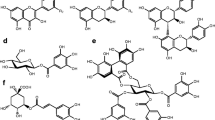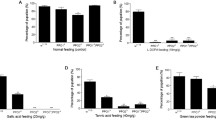Abstract
Final-instarMalacosoma disstria fed artificial diets containing tannic acid develop lethal pupal deformities. We examined some of the factors potentially underlying tannin sensitivity in this species, including the permeability of the peritrophic envelope to tannic acid and the chemical fate of tannic acid in the gut. Tannic acid does not penetrate the peritrophic envelope ofM. disstria, demonstrating that the containment of tannic acid within the endoperitrophic space is not sufficient to protect an insect herbivore from the adverse effects of ingested tannins. Ingested tannic acid undergoes extensive chemical modification in the midgut. Only 19–21 % of the high molecular weight components of the tannic acid ingested was recovered in the frass. Of two possible chemical fates of ingested tannic acid, oxidation is the predominant chemical transformation, whereas little hydrolysis occurs. Measurements of gut redox parameters showed that conditions in the midgut favor the oxidation of phenols. However, similar conditions occur in the midguts ofOrgyia leucostigma, in which no oxidation occurs. Therefore, oxidizing gut redox conditions do not necessarily lead to polyphenol oxidation in lepidopteran larvae. We conclude that the sensitivity ofM. disstria to ingested tannins is a consequence of their oxidation in the midgut.
Similar content being viewed by others
References
Adang, M.J., andSpence, K.D. 1983. Permeability of the peritrophic membrane of the Douglas fir tussock moth (Orgyia pseudotsugata).Comp. Biochem. Physiol. 75A:233–238.
Addy, N.D. 1969. Rearing the forest tent caterpillar on an artificial diet.J. Econ. Entomol. 62:270–271.
Appel, H.M. 1993. Phenolics in ecological interactions: the importance of oxidation.J. Chem. Ecol. 19:1521–1552.
Appel, H.M., andMartin, M.M. 1990. Gut redox conditions in herbivorous lepidopteran larvae.J. Chem. Ecol. 16:3277–3290.
Austin, P.J., Suchar, L.A., Robbins, C.T., andHagerman, A.E. 1989. Tannin binding proteins in the saliva of deer and their absence in the saliva of sheep and cattle.J. Chem. Ecol. 15:1335–1347.
Barbehenn, R.V., andMartin, M.M. 1992. The protective role of the peritrophic membrane in the tannin-tolerant larvae ofOrgyia leucostigma (Lepidoptera).J. Insect Physiol. 38:973–980.
Berenbaum, M. 1983. Effect of tannins on growth and digestion in two species of papilionids.Entomol. Exp. Appl. 34:245–250.
Bernays, E.A., Chamberlain, D., andMcCarthy, P. 1980. The differential effects of ingested tannic acid on different species of Acridoidea.Entomol. Exp. Appl. 28:158–166.
Bernays, E.A., Chamberlain, D.J., andWoodhead, S. 1983. Phenols as nutrients for a phytophagous insectAnacridium melanorhodon.J. Insect Physiol. 29:535–539.
Chang, R.L.S., Deen, W.M., Robertson, C.R., andBrenner, B.M. 1975. Permselectivity of the glomerular capillary wall: III. Restricted transport of polyanions.Kidney Int. 8:212–218.
Chippendale, G.M., Beck, S.D., andStrong, F.M. 1964. Methyl linolenate as an essential nutrient for the cabbage looper,Trichoplusia ni (Hübner).Nature 204:710–711.
Cilliers, J.J.L., andSingleton, V.L. 1989. Nonenzymic autoxidative phenolic browning reactions in a caffeic acid model system.J. Agric. Food Chem. 37:390–396.
Dadd, R.H. 1981. Essential fatty acids for mosquitoes, other insects and vertebrates, pp. 189–214,in G. Bhaskaran, S. Friedman, and J.G. Rodriguez (eds.). Current Topics in Insect Endocrinology and Nutrition. Plenum Press, New York.
De Veau, E.J.I., andSchultz, J.C. (1992). Reassessment of the interaction between gut detergents and phenolics in Lepidoptera and significance for gypsy moth larvae.J. Chem. Ecol. 18:1437–1453.
Dow, J.A.T. 1986 Insect midgut function.Adv. Insect Physiol. 19:188–328.
Feeny, P. 1968. Effect of oak leaf tannins on larval growth of the winter mothOperophtera brumata.J. Insect Physiol. 14:805–817.
Feeny, P. 1970. Seasonal changes in oak leaf tannins and nutrients as a cause of spring feeding by winter moth caterpillars.Ecology 51:565–581.
Feeny, P. 1976. Plant apparency and chemical defense, pp. 1–40,in J.W. Wallace and R.L. Mansell (eds.). Biochemical Interactions Between Plants and Insects. Plenum Press, New York.
Felton, G.W., andDuffey, S.S. 1991. Protective action of midgut catalase in lepidopteran larvae against oxidative plant defenses.J. Chem. Ecol. 17:1715–1732.
Felton, G.W., andDuffey, S.S. 1992. Ascorbate oxidation reduction inHelicoverpa zea as a scavenging system against dietary oxidants.Arch. Insect Biochem. Physiol. 19:27–37.
Felton, G.W., Donato, K., Del Vecchio, R.J., andDuffey, S.S. 1989. Activation of plant polyphenol oxidases by insect feeding reduces the nutritive quality of foliage for noctuid herbivores.J. Chem. Ecol. 15:2667–2694.
Hagerman, A.E. 1989. Chemistry of tannin-protein complexation, pp. 323–333,in R.W. Hemingway and J.J. Karchesy (eds.). Chemistry and Significance of Condensed Tannins. Plenum Publishing Corp., New York.
Hagerman, A.E., andButler, L.G. 1991. Tannins and lignins, pp. 355–388,in G.A. Rosenthal and M.R. Berenbaum (eds.). Herbivores: Their Interactions with Secondary Plant Metabolites, 2nd ed., Vol. 1: The Chemical Participants. Academic Press, San Diego, California.
Hathway, D.E., andSeakins, J.W.T. 1957. Autoxidation of polyphenols. Part 3. Autoxidation in neutral aqueous solution of flavans related to catechin.J. Chem. Soc. 2:1562–1566.
Igarashi, K., andYasui, T. 1985. Oxidation of free methionine and methionine residues in protein involved in the browning reaction of phenolic compounds.Agric. Biol. Chem. 49:2309–2315.
Ikeda, I., Imasato, Y., Sasaki, E., Nakayama, M., Nagao, H., Takeo, T., Yayabe, F., andSugano, M. 1992. Tea catechins decrease micellar solubility and intestinal absorption of cholesterol in rats.Biochim. Biophys. Acta 1127:141–146.
Inoue, K.H., andHagerman, A.E. 1988. Determination of gallotannin with rhodanine.Anal. Biochem. 169:363–369.
Isman, M.B., andDuffey, S.S. 1982. Toxicity of tomato phenolic compounds to the fruitworm,Heliothis zea. Entomol. Exp. Appl. 31:370–376.
Karowe, D. 1989. Differential effect of tannic acid on two tree-feeding Lepidoptera: Implications for theories of plant-herbivore chemistry.Oecologia 80:507–512.
Kato, M. 1978. Phenols as indispensible components of the synthetic diet of the silkworm,Bombyx mori.Entomol. Exp. Appl. 24:284–290.
Klocke, J.A., andChan, B.G. 1982. Effects of cotton condensed tannin on feeding and digestion in the cotton pest,Heliothis zea.J. Insect Physiol. 28:911–915.
Larson, R.A. 1988. The antioxidants of higher plants.Phytochemistry 27:969–978.
Lea, C.H. 1962. The oxidative deterioration of food lipids, pp. 3–28,in H.W. Schultz (ed.). Symposium in Foods: Lipids and their Oxidation. Avi Publishing, Westport, Connecticut.
Leatham, G.F., King, V., andStahmann, M.A. 1980. In vitro protein polymerization by quinones or free radicals generated by plant or fungal oxidative enzymes.Phytopathology 70:1134–1140.
Lindsay, W.L. 1979. Chemical Equilibria in Soils. John Wiley & Sons, New York.
Manuwoto, S., andScriber, J.M. 1986. Effects of hydrolyzable and condensed tannin on growth and development of two species of polyphagous Lepidoptera:Spodoptera eridania andCallosamia promethea.Oecologia 69:225–230.
Manuwoto, S., Scriber, J.M., Hsia, M.T., andSunarjo, P. 1985. Antibiosis/antixenosis in tulip tree and quaking aspen leaves against the polyphagous southern armyworm,Spodoptera eridania.Oecologia 67:1–7.
Miller, N., andLehane, M.J. 1993. Ionic environment and the permeability properties of the peritrophic membrane ofGlossina morsitans morsitans.J. Insect Physiol. 39:139–144.
Rehr, S.S., Janzen, D.H., andFeeny, P.P. 1973.l-Dopa in legume seeds: A chemical barrier to insect attack.Science 181:81–82.
Rhoades, D.F., andCates, R.G. 1976. Toward a general theory of plant antiherbivore chemistry.Recent Adv. Phytochem. 10:168–213.
Rosenthal, G.A. 1977. The biological effects and mode of action ofl-canavanine, a structural analogue ofl-arginine.Q. Rev. Biol. 52:155–178.
Santos, C.D., andTerra, W.R. 1986. Distribution and characterization of oligomeric digestive enzymes fromErinnyis ello larvae and inferences concerning secretory mechanisms and the permeability of the peritrophic membrane.Insect Biochem. 16:691–700.
Schultz, J.C. 1989. Tannin-insect interactions, pp. 417–433,in R.W. Hemingway and J.J. Karchesy (eds.). Chemistry and Significance of Condensed Tannins. Plenum Press, New York.
Stehr, F.W., andCook, E.F. 1968. A revision of the genusMalacosoma Hübner in North Americana (Lepidoptera: Lasiocampidae): Systematics, biology, immatures, and parasites. Smithsonian Institution Press, Washington, D.C.
Steinly, B.A., andBerenbaum, M. 1985. Histopathological effects of tannins on the midgut epithelium ofPapilio polyxenes andPapilio glaucus.Entomol. Exp. Appl. 39:3–9.
Summers, C.B., andFelton, F.W. 1993. Antioxidant role of dehydroascorbic acid reductase in insects.Biochim. Biophys. Acta 1156:235–238.
Thomson, R.H. 1962. Some naturally occurring black pigments, pp. 99–113,in T.S. Gore, B.S. Joshi, S.V. Sunthankar, and B.D. Tilak (eds.). Recent Progress in the Chemistry of Natural and Synthetic Colouring Matters and Related Fields. Academic Press, New York.
Wolfersberger, M.G., Spaeth, D.D., andDow, J.A.T. 1986. Permeability of the peritrophic membrane of tobacco hornworm larval midgut.Am. Zool. 26:74A.
Author information
Authors and Affiliations
Rights and permissions
About this article
Cite this article
Barbehenn, R.V., Martin, M.M. Tannin sensitivity in larvae ofMalacosoma disstria (Lepidoptera): Roles of the peritrophic envelope and midgut oxidation. J Chem Ecol 20, 1985–2001 (1994). https://doi.org/10.1007/BF02066238
Received:
Accepted:
Issue Date:
DOI: https://doi.org/10.1007/BF02066238




